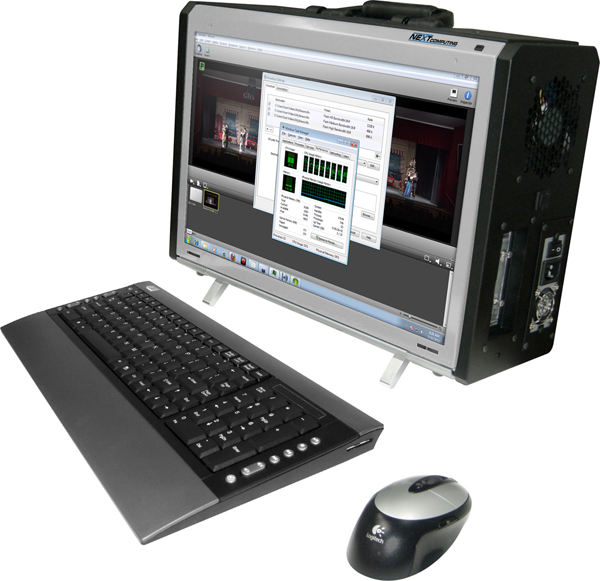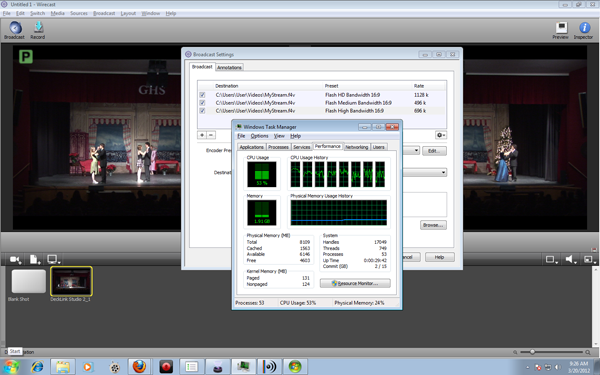Producing a Live Concert Webcast with the Next Computer Radius and the Roland VR-3
Video production and encoding expert Jan Ozer describes the workflow and challenges of a Livestream webcast he produced for marimba player Larissa Venzie using the Roland VR-3 and Next Computer's Radius portable workstation.
The Radius
Once I got everything working, I plugged the composite video and RCA audio outputs into the DeckLink card that I had installed in the Radius unit, a briefcase-like computer that's about 17" wide, 15" high, and 6" deep and weighs up to 22 pounds, depending upon configuration. For travel, you cover the 17" HD display with a thin aluminum cover that screws on and off in seconds. There isn't a keyboard embedded into the chassis, so I used a third party keyboard and mouse.
My unit came with a 4-core (eight with hyperthreading enabled) 3.4 GHz IntelCore i7-2600 CPU with 8GB of RAM running 64-bit Windows 7, though you can pack up to 32 GB into the system. If you run the system off the embedded graphics in the Intel CPU, you have four open slots. If you need graphics horsepower for CUDA acceleration or 3D design work, you can install an NVIDIA or other workstation card, and still have three slots left. Since I didn't plan to edit the video, I worked off the embedded graphics which ran just fine.

The 4-core HTT 3.4GHz i7-2600 Next Computer Radius I used to run the webcast
Pushing out a single stream configured at 512x384@400 Kbps, the computer ran between 15-20% CPU utilization as shown on the Livestream Procaster interface. This would have left plenty of overhead for an HD stream, or even multiple HD/SD streams. To confirm this, back in my office, I loaded a copy of Wirecast onto the system, and connected the component outputs from the XH A1 into the Decklink card. I popped an old tape of a ballet concert into the camera and started broadcasting four steams of mixed HD and SD footage.
Specifically, I used Wirecast's HD, Large, and Medium 16:9 H.264 presets, which are configured at 720p@ 1 mbps, 960x540@600 kbps, and 720x405@ 400 kbps, and then added the low bandwidth 320x240@200 kbps preset. In this configuration, storing the encoded files to disk, CPU utilization ranged from 52 - 60%, leaving plenty of overhead for occasional spikes. This should be more than sufficient computing for all but the largest webcasts.

CPU Utilization on the Radius when running 3 streams in Wirecast. I later boosted this to four streams for my CPU utilization tests.
The Livestream Connection
Livestream is one of the big three live streaming service providers in the US, along with Ustream and Justin.tv. As with Ustream, you can broadcast for free with an advertising supported service, or pay a fee to stream without ads, a so called white-label service. Justin.tv, which targets mostly gamers, does not offer a white label version.
Livestream offers a very simple browser-based encoding utility called Broadcaster, but this outputs VP6, not H.264, so the stream won't play on mobile devices. So I used Livestream's downloadable broadcasting application, Procaster, which encodes to H.264 and is available for both Mac and Windows.
One of the nicest things about using the software provided by service providers like Livestream is ease of use. Once you login to the software, you're automatically connected to the live streaming server, so there are no server address URLs to identify and type or copy in.
You can also customize a landing page for viewers to watch the concert, complete with features like chat via Facebook, Twitter, or Livestream's own native chat capability. The day before the concert, I copied the banner and some text from Larissa's own web site to create the landing page, which took under ten minutes. Ultimately, Larissa chose to broadcast the concert from her own website, which she did by grabbing the embed code from the Livestream landing page, pretty much like embedding a YouTube video. If you decide to embed the video into your own website, you can also disable the landing page within Livestream, leaving your own site as the only available viewing option.
Related Articles
This capture software was developed to meet the request from Windows users who want to record/capture the audio and video during live events using any of the products from the Roland VR or VC line-up
If you're in the market for an all-in-one video mixer for webcasting 4:3 NTSC video, Roland's compact new VR-3 fits the bill nicely. If you need widescreen video output, you may need to add some steps to your workflow when you pair NTSC widescreen video with many of the popular streaming services.